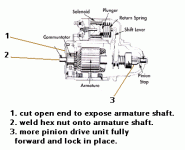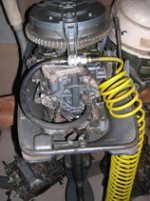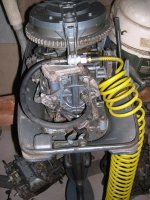Hello, I'm new to the forum and have little experience with Chris Craft motors (although plenty of experience with engines in general) so please forgive any dumb questions! I have a 1957 30' Constellation with twin 283s. Unfortunately the boat has been sitting for the last year or so with no batteries or fuel tanks as I have been making slow progress on cockpit deck repairs (long story involving pulling the tanks to get at the shaft logs to stop severe leaking due to corroded bolts...).
I had been turning the motors over with the starter every few weeks but since I pulled the batteries last year they have been just sitting and are now frozen. While at some point I do want to strip them down and rebuild I'm hoping that for now I can free them up without pulling them out of the boat. To that end I have sprayed penetrating lubricant (PB Blaster) into the combustion chambers and am letting them pickle for a few days.
Once the lubricant has had some time to work I will try to turn the motors over by hand but I am not sure how to do that as there is no bolt on the end of the crankshaft and as far as I can tell the hole in the end of the crankshaft is not threaded. There is a pulley bolted to the crankshaft via 4 bolts and I had thought of making a tool that would bolt to the same location but am looking for alternate suggestions. Anyone? Any opinions on my chances of success are also welcome...
Thanks,
Chris
I had been turning the motors over with the starter every few weeks but since I pulled the batteries last year they have been just sitting and are now frozen. While at some point I do want to strip them down and rebuild I'm hoping that for now I can free them up without pulling them out of the boat. To that end I have sprayed penetrating lubricant (PB Blaster) into the combustion chambers and am letting them pickle for a few days.
Once the lubricant has had some time to work I will try to turn the motors over by hand but I am not sure how to do that as there is no bolt on the end of the crankshaft and as far as I can tell the hole in the end of the crankshaft is not threaded. There is a pulley bolted to the crankshaft via 4 bolts and I had thought of making a tool that would bolt to the same location but am looking for alternate suggestions. Anyone? Any opinions on my chances of success are also welcome...
Thanks,
Chris





